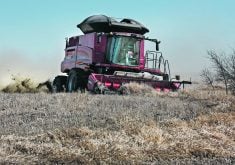Controlling wild mustard
Newly released results show how a little wild mustard can devastate a canola crop.
Field trials by Agriculture Canada show it takes only a handful of wild mustard plants to drop yields by 15 to 20 percent and only a few more to raise dockage levels above the allowable five percent for grades better than sample.
In a three-year study conducted at the Lacombe Research Station, as few as three mustard plants per square metre reduced canola yields by 13 percent. Researcher Anne de St. Remy found 20 wild mustard plants per square metre could reduce yield by 20 to 35 percent, depending on the canola variety.
Read Also

VIDEO: Green Lightning and Nytro Ag win sustainability innovation award
Nytro Ag Corp and Green Lightning recieved an innovation award at Ag in Motion 2025 for the Green Lightning Nitrogen Machine, which converts atmospheric nitrogen into a plant-usable form.
Muster herbicide, made by DuPont Canada Inc., is the only herbicide currently registered to control wild mustard in non-TTC (triazine tolerant) canola.
As farmers’ canola acreage grows so does their wild mustard problem: some are sowing canola in fields with wild mustard already present.
Wild mustard infestation should not be ignored. A trial run on a farm in Lakeland, Man. in 1992 comparing crops from untreated and treated fields showed an overall gain of $123 an acre (see chart).
- DuPont Canada
Raising young horses
A recent study at the University of Saskatchewan looked at the problems producers of pregnant mare’s urine and other horse owners can have raising young horses.
Young mares of two to three years of age are used as replacements in the PMU industry, but they can have low conception rates and may have poor foal survival, said researcher Nadia Cymbaluk. The study found that poor foal survival was largely a problem of poor mothering and a low transfer of the immunity usually provided through colostrum (first milk). Young mares also lose more weight during the nursing period, and their foals fail to grow as well as foals born to older mares.
“Our study found that early weaning — about three months — benefited both the foal and the young mare, and should be used by PMU producers to improve their foal and mare productivity,” said Cymbaluk.
It was shown that neither heated housing nor high grain (more than 50 percent) diets were necessary components of good management of weanlings. The study showed weanlings easily tolerated temperatures of 0¡C without needing extra energy intake. The weanlings also grew as well on a high-hay diet of 65 percent hay as on the recommended high-grain diet of 65 percent grain.
Cymbaluk says current recommendations for raising weanling horses is to raise foals outdoors to provide sufficient exercise, and to feed them diets in which hay accounts for at least 50 to 60 percent of their intake.
- Saskatchewan Agriculture
















